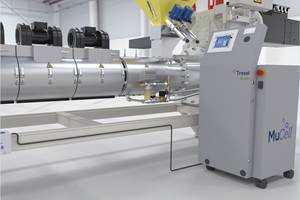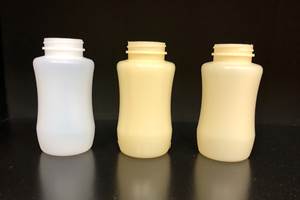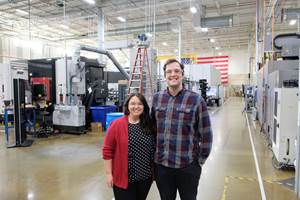Dedusting Turns Risky Regrind Into a Valuable Resource
Custom injection molder Tessy Plastics, Elbridge, N.Y., used to spend around $117,000 every year on resins that it would not use.
Custom injection molder Tessy Plastics, Elbridge, N.Y., used to spend around $117,000 every year on resins that it would not use. That amount was how much the molder figured was lost by generating just 1% scrap from processing 180,000 lb of resins a week, averaging $1.25/lb.
It wasn’t that the company didn’t want to reuse that scrap. “We know that if conditions are right, molders can significantly increase profit margins by increasing the amount of regrind used in the production process,” says Allan Sheriff, inventory control supervisor at Tessy. What kept this molder from using most of its regrind was the very real possibility that it would cause even more wasted material.
Regrind can be risky
Tessy has 131 injection presses in two buildings at Elbridge. (It also has smaller facilities in Lynchburg, Va., and Shanghai, China.) The firm runs a variety of thermoplastics but uses mostly polycarbonate. It makes 130 or so job changeovers at Elbridge every week, which generates scrap while molds are being started up and conditions optimized, says Sheriff.
The company has shredders and granulators to regrind runners and parts, but until relatively recently, Tessy rarely ran regrind. “It just wasn’t worth the effort because regrind has a downside—dust,” warns Sheriff. “In many instances the dust content in the regrind reaches more than 10%. Even in virgin pellets, dust content of 1% by weight is considered significant,” says Sheriff. Use of dusty regrind often resulted in a myriad of part or process problems. “The dust would cause problems in the molding machine, such as affecting the cushion of the injection cycle. This could lead to material degradation. Some material would actually burn. The dust in the regrind could cause cosmetic problems such as specks and swirls and discoloration. If we were fortunate we could sell the dust to a recycler, but if we found no market for it we would just throw it away,” says Sheriff.
Tessy didn’t think upgrading its size reduction technology was an answer, since it was not clear that a new shredder or granulator would do a better job in reducing the dust.
Getting the dust out
During a $7.6-million expansion, the company invested in material dedusting technology, purchasing a unit from Pelletron Corp., Lancaster, Pa. The deduster, installed apart from the presses and near the regrind room, uses a flux-field generator to disrupt the static charge between the regrind and the dust particles. The system uses air to lift the dust away from the resin, and then a vacuum system removes the dust, leaving the cleaned regrind to fall into a bottom storage bin for reuse.
Tessy is now able to mold parts to specification while including some regrind material in the part to help reduce cost. “Currently 50 of our jobs use reground and dedusted material where previously it was zero. A job may now contain anywhere from 10% to 35% regrind,” says Sheriff. For one customer Tessy was able to produce two orders of product using 100% regrind. “That cut our customer’s costs by more than 50%,” Sheriff adds. Tessy even uses the deduster on its virgin resins to minimize the chance of quality problems.
Without the dedusting Tessy says its production efficiency was about 80% over 24 hr, but with the deduster it is easily between 90% and 100% efficient.
Tessy says the dedusters require little maintenance, just filter replacement two or three times a year. The firm now has two Pelletron P10 mid-range Dedusters (1000 lb/hr) and is looking to purchase a P1 mini DeDuster that mounts atop the hopper for dedusting at the machine.
Related Content
Processing Megatrends Drive New Product Developments at NPE2024
It’s all about sustainability and the circular economy, and it will be on display in Orlando across all the major processes. But there will be plenty to see in automation, AI and machine learning as well.
Read MoreFoam-Core Multilayer Blow Molding: How It’s Done
Learn here how to take advantage of new lightweighting and recycle utilization opportunities in consumer packaging, thanks to a collaboration of leaders in microcellular foaming and multilayer head design.
Read MoreHow to Extrusion Blow Mold PHA/PLA Blends
You need to pay attention to the inherent characteristics of biopolymers PHA/PLA materials when setting process parameters to realize better and more consistent outcomes.
Read MoreScaling Up Sustainable Solutions for Fiber Reinforced Composite Materials
Oak Ridge National Laboratory's Sustainable Manufacturing Technologies Group helps industrial partners tackle the sustainability challenges presented by fiber-reinforced composite materials.
Read MoreRead Next
Beyond Prototypes: 8 Ways the Plastics Industry Is Using 3D Printing
Plastics processors are finding applications for 3D printing around the plant and across the supply chain. Here are 8 examples to look for at NPE2024.
Read MoreFor PLASTICS' CEO Seaholm, NPE to Shine Light on Sustainability Successes
With advocacy, communication and sustainability as three main pillars, Seaholm leads a trade association to NPE that ‘is more active today than we have ever been.’
Read MoreMaking the Circular Economy a Reality
Driven by brand owner demands and new worldwide legislation, the entire supply chain is working toward the shift to circularity, with some evidence the circular economy has already begun.
Read More












